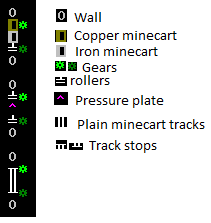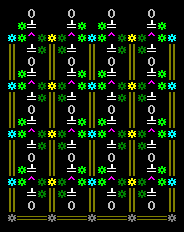- v50 information can now be added to pages in the main namespace. v0.47 information can still be found in the DF2014 namespace. See here for more details on the new versioning policy.
- Use this page to report any issues related to the migration.
Difference between revisions of "v0.34:Minecart logic"
TinyPirate (talk | contribs) (Created page with "The addition of minecarts to Dwarf Fortress has opened up new and exciting logic and computing options for the ambitious fortress manager. Minecart-based logic gates and memory c...") |
TinyPirate (talk | contribs) |
||
| Line 1: | Line 1: | ||
The addition of minecarts to Dwarf Fortress has opened up new and exciting logic and computing options for the ambitious fortress manager. Minecart-based logic gates and memory cells are easy to build (arguably easier than [[fluid logic]] systems, they are easy to reconfigure, and react quickly. | The addition of minecarts to Dwarf Fortress has opened up new and exciting logic and computing options for the ambitious fortress manager. Minecart-based logic gates and memory cells are easy to build (arguably easier than [[fluid logic]] systems, they are easy to reconfigure, and react quickly. | ||
| + | |||
| + | == Binary Memory Cells == | ||
| + | Binary Memory Cells store binary data as a 1 or 0 (on or off). For minecarts this means a minecart occupies a pressure plate to create a 1 and by some means removed to make a 0. | ||
| + | |||
| + | |||
| + | === Three-tracked double-carted binary memory cell === | ||
| + | |||
| + | [[File:3tdcbm.png]] | ||
| + | |||
| + | The image is split into three versions to show where the minecarts go, what's beneath the minecarts and what's beneath the rollers and pressure plates. | ||
| + | |||
| + | How this works: There are 2 carts, a copper one at the top and an iron one in the center. A copper cart weighs 357 Urists and an iron cart 314 Urists. The pressure plate in the center is set to activate at 350 Urists, so the iron cart doesn't trigger it. Activating the gear/roller (the light green one), making the copper cart push the iron cart to the other end before rolling onto the pressure plate will trigger it and send an on signal. Vice versa (the iron cart will push the copper cart just fine even though it's a little bit lighter) to send an off signal. This design is the most space-efficient of the memory cells but lacks the activation speed of the next design due to the first cart having to push the second cart before being moved onto the pressure plate itself. | ||
| + | |||
| + | A modular example of this design: | ||
| + | |||
| + | [[File:Modular3tdcbm.png]] | ||
| + | |||
| + | It's a bit bulky looking but compared to the water based cell which needs 5 z-levels minimum to be of any worth, it's nearly 3x smaller and functions just the same. | ||
Revision as of 10:24, 7 September 2012
The addition of minecarts to Dwarf Fortress has opened up new and exciting logic and computing options for the ambitious fortress manager. Minecart-based logic gates and memory cells are easy to build (arguably easier than fluid logic systems, they are easy to reconfigure, and react quickly.
Binary Memory Cells
Binary Memory Cells store binary data as a 1 or 0 (on or off). For minecarts this means a minecart occupies a pressure plate to create a 1 and by some means removed to make a 0.
Three-tracked double-carted binary memory cell
The image is split into three versions to show where the minecarts go, what's beneath the minecarts and what's beneath the rollers and pressure plates.
How this works: There are 2 carts, a copper one at the top and an iron one in the center. A copper cart weighs 357 Urists and an iron cart 314 Urists. The pressure plate in the center is set to activate at 350 Urists, so the iron cart doesn't trigger it. Activating the gear/roller (the light green one), making the copper cart push the iron cart to the other end before rolling onto the pressure plate will trigger it and send an on signal. Vice versa (the iron cart will push the copper cart just fine even though it's a little bit lighter) to send an off signal. This design is the most space-efficient of the memory cells but lacks the activation speed of the next design due to the first cart having to push the second cart before being moved onto the pressure plate itself.
A modular example of this design:
It's a bit bulky looking but compared to the water based cell which needs 5 z-levels minimum to be of any worth, it's nearly 3x smaller and functions just the same.

